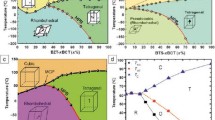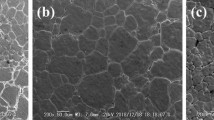Abstract
A new lead-free perovskite piezoelectric solid solution (1−x)BaTiO3–xZnSnO3 (BT–xZS) was designed and fabricated using the traditional solid-state reaction method. The introduction of ZnSnO3 was found to shift the high-temperature cubic phase of BaTiO3 to lower temperatures. At room temperature large electrostrictive coefficient up to 0.0452 m4 C−2 was obtained in BT–0.10ZS ceramic, which is much larger than the traditional electrostrictive material Pb(Mg1/3Nb2/3)O3 and recently reported lead-free electrostrictive systems. The large electrostrictive response of BT–xZS ceramics makes them quite potential to be applied to new solid-state actuators.
Similar content being viewed by others
Avoid common mistakes on your manuscript.
1 Introduction
Piezoelectric actuators, having significant applications in ultra-small-scale motion, fuel injectors, micro-pumps, ink cartridges medical surgery instruments, etc., attracted continuous attentions and the overall market increased with an annual growth rate of 13% [1]. The dominant materials utilized in piezoelectric actuators are the lead-based solid solutions represented by Pb(Zr,Ti)O3 (PZT) [1]. Nevertheless, the lead is toxic, and developing new lead-free alternative that can replace the PZT system has received great interest recently [2,3,4,5,6,7]. During the reported lead-free piezoelectric systems, the KNN-based solid solution suffered from the problem of strong temperature-dependent piezoelectric response while the BNT-based systems were always accompanied with large strain hysteresis [2]. An alternative way is to developing lead-free electrostrictive system, which has the distinguished advantages of good temperature stability, no poling requirement and fast response [8, 9].
Recently much progress has been made in developing lead-free electrostrictive alternatives. High-strain lead-free electrostrictors were proposed in BNT–BT–KNN, BTZ–BCT, BNT–BT–BFO and NaNbO3–BaTiO3 solid solutions, which can provide high strain and minimal losses at room temperature combined with minimal temperature dependence [8, 10,11,12]. The electrostrictive coefficient was improved from 0.022 to 0.046 m4 C−2, exhibiting quite potential in high-precision ceramic actuators. It is, therefore, quite interesting and necessary to search for more high-performance lead-free electrostrictors for solid-state actuator applications.
In recent study, a novel solid solution ZnSnO3 was theoretically proposed and experimentally synthesized [13, 14]. The calculated polarization P was up to 59 µC cm−2, which is a promising lead-free candidate. Nevertheless, the pure ZnSnO3 could only be synthesized under high-pressure conditions (the mixture of stoichiometric amounts of ZnO and SnO2 could react in a high-pressure apparatus at 7 GPa and 1000 °C for 30 min and then the apparatus was quenched to room temperature) which caused great inconvenience for practical applications. An alternative routine was to design and form new solid solution. Under these considerations, a binary solid solution (1 − x)BaTiO3–xZnSnO3 (BT–xZS), exhibiting excellent electrostrictive response, was designed and fabricated through the introduction of ZnSnO3 into a typical lead-free system of BaTiO3. The influences of ZnSnO3 substitution on the structure, dielectric, piezoelectric, ferroelectric, electrostrictive properties, and the phase transition characteristics were investigated. It’s worth noting that at a critical composition x of 0.10, large electrostrictive coefficient as high as 0.0452 m4 C−2 was obtained under a moderate field of 4 kV mm−1 around room temperature. The excellent electrostrictive performance makes the BT–xZS system great potential in environmental-friendly solid-state actuator.
2 Experimental
The BT–xZS (x = 0, 0.02, 0.05, 0.07, 0.10, 0.12, 0.15) solid solution was fabricated via conventional solid-state reaction method. The starting raw materials were weighed and milled for 6 h followed by calcination at 1100 °C for 2 h. Then the powder was ball milled again for 6 h. The obtained powders were then pressed into disks and finally sintered at 1300–1350 °C for 2 h. The specimens were covered with electrode and poled in silicone oil under 4 kV mm−1.
The crystal structures were characterized by X-ray diffractometry (D8 Focus, Germany) using unpoled crushed sintered samples. The dielectric constant (\( \varepsilon_{33}^{T} /\varepsilon_{0} \)) and loss (tanδ) were measured using an automatic acquisition system with an impedance analyzer (Agilent HP4294A, Santa Clara, CA, USA). The ferroelectric hysteresis loops and strain curves were measured in silicon oil at 10 Hz with the aid of a ferroelectric analyzer (TF2000 analyzer, Aixacct, Aachen, Germany) along with a laser interferometer. The ferroelectric domain structure was characterized by piezoresponse force microscopy (PFM, MFP-3D, Asylum Research, USA).
3 Results and discussion
The measured X-ray diffraction (XRD) patterns for the BT–xZS ceramics with x from 0 to 0.15 in the 2θ range of 20°–70° are shown in Fig. 1a. From Fig. 1a, all the compositions exhibited typical perovskite structure. Careful observation revealed that there existed a small amount of second phase in the 2θ angle of 33.6° for the compositions x of 0.12 and 0.15. For the sintering temperature range up to 1350 °C, the second phase could still be detected. Higher temperature and high pressure may be required to obtain pure phase structure for the compositions x > 0.12. From Fig. 1b, it can be found that the introduction of the ZnSnO3 caused the crystal lattice distortion and shifted the diffraction peaks towards lower 2θ direction due to larger crystal spacing of ZnSnO3. For pure BaTiO3 ceramics, obvious splitting could be observed for (100) and (200) peaks, indicating the ferroelectric tetragonal phase at room temperature. The substitution of ZnSnO3 weakened the tetragonal distortion and induced the formation of pseudocubic or cubic structure characterized by no peak splitting for both (111) and (200) peaks.
Figures 2 and 3 show the composition, temperature, and frequency dependence of dielectric constant (\( \varepsilon_{33}^{T} /\varepsilon_{0} \)) and loss (tanδ) for the unpoled and poled BT–xZS ceramics. Four representative compositions x of 0.02, 0.05, 0.07, and 0.10 are shown here. Compared to the normal ferroelectric BaTiO3 with sharp ferroelectric to cubic phase transition peak, diffused phase transition process characterized by the broad dielectric peaks can be well observed after the introduction of the ZnSnO3. However, little frequency dispersion in the dielectric constant and loss could be detected in both unpoled and poled ceramics which is different from those of the Bi0.5Na0.5TiO3–BaTiO3 system [3,4,5]. A schematic phase diagram was constructed for poled BT–xZS ceramics as shown in Fig. 4. The Tm was shifted to low temperatures as the ZnSnO3 concentration increased. At a critical composition of BT–0.10ZS, the Tm was located around room temperature, indicating that the cubic phase became the dominant one.
Figure 5 shows the room-temperature ferroelectric P–E loops, and electric-field-induced bipolar strain curves for the pure BaTiO3 ceramic. Typical rectangular P–E loop along with butterfly-shaped strain curve could be observed, indicating the strong ferroelectric long-range-order. Figure 6 shows four representative room-temperature ferroelectric P–E loops, and electric-field-induced bipolar strain curves for BT–xZS with x of 0.02, 0.05, 0.07, and 0.10 at 10 Hz. From Fig. 6a, after the introduction of the ZnSnO3, the ferroelectric long-range-order was disrupted characterized by the sharply decreased remnant polarization and coercive field. All the compositions of the BT–xZS ceramics exhibited weak ferroelectric polarization and the P–E loops became slimmer slightly with the compositions increasing. The slightly nonlinear P–E loops under the fields of 4 kV mm−1 were slimmer than that of other lead-free or lead-containing electrostrictors [9, 10]. On the other hand, the S–E curves show very little hysteresis with strain value in the range of 0.022–0.033% as shown in Fig. 6b and the strain value decreased gradually with the compositions increasing. To give an insight into the intrinsic mechanism for the ferroelectric and strain properties evolution, PFM was further utilized to measure the domain structure in nanoscale. Figure 7 shows the domain structures for the BT–xZS system with x of 0 and 0.10. Clear contrast and apparent fingerprint pattern ferroelectric domains with the domain length up to ~ 2 μm could be observed for pure BaTiO3, consistent with strong ferroelectric long-range-order from the P–E loop in Fig. 5a. In comparison, the BT–0.10ZS exhibited quite weak contrast from the PFM phase image. Only a small fraction of dark contrast could be detected. The results indicated that after the ZnSnO3 substitution, the ferroelectric domain structure with the size of micrometer was destroyed. A phase transformation from ferroelectric tetragonal phase with typical ferroelectric domain structure to near “non-ferroelectric” state was induced. Combined with the dielectric spectrum shown in Figs. 2 and 3, it can be concluded that the high-temperature cubic phase was shifted downwards. Therefore, the remnant polarization and strain value decreased substantially. In addition, from Fig. 6a, the energy content in the ferroelectric hysteresis loop decreased with the composition x increasing and a purely electrostrictive response was induced in the critical composition BT–0.10ZS.
Figure 8 shows the relations of the strain responses vs. the square of the ferroelectric polarization. A linear relation could be found, indicating an electrostrictive behavior and the electrostrictive coefficient Q could be obtained from the following formula,
where the S and P were the electric-field-induced strain and ferroelectric polarization, respectively. Obviously, the S–P2 curves for all the compositions were linear, which meant all the compositions were pure electrostrictors. The electrostrictive coefficient Q was calculated to be 0.0328 m4 C−2, 0.0339 m4 C−2, and 0.0342 m4 C−2 for the compositions x of 0.02, 0.05, 0.07, respectively. It is worth noting that the largest electrostrictive coefficient Q was obtained for BT–0.10ZS with the value up to 0.0452 m4 C−2. This value is superior to the well-known electrostrictive material Pb(Mg1/3Nb2/3)O3 (PMN) of 0.017 m4 C−2 and notably larger than that of the recently reported BNT–BT–KNN, BNT–BT–KN, BTZ–BCT, etc. [8, 11, 12, 15, 16]. The excellent electrostrictive response makes BT–xZS quite potential in solid-state actuators applications.
4 Conclusions
In this paper, a new lead-free electrostrictive solid solution BT–xZS was proposed. The introduction of ZnSnO3 was found to shift the high-temperature cubic phase to low temperature, accompanying by the weakened ferroelectric polarization and domain pattern. At a critical composition x of 0.10, high electrostrictive coefficient Q as high as 0.0452 m4 C−2 can be obtained at room temperature, much larger than that of the well-known PMN and other lead-free electricstrictors. This makes BT–xZS quite potential in lead-free high-precision solid-state actuators.
References
W. Jo, R. Dittmer, M. Acosta, J.D. Zang, C. Groh, E. Sapper, K. Wang, J. Rödel, J. Electroceram. 29, 71 (2012)
J. Rödel, W. Jo, K.T.P. Seifert, E.M. Anton, T. Granzow, D. Damjanovic, J. Am. Ceram. Soc. 92, 1153 (2009)
F.F. Wang, M. Xu, Y.X. Tang, T. Wang, W.Z. Shi, C.M. Leung, J. Am. Ceram. Soc. 95, 1955 (2012)
F.F. Wang, C.M. Leung, Y.X. Tang, T. Wang, W.Z. Shi, J. Appl. Phys. 114, 164105 (2013)
Q.R. Yao, F.F. Wang, F. Xu, C.M. Leung, T. Wang, Y.X. Tang, X. Ye, Y.Q. Xie, D.Z. Sun, W.Z. Shi, A.C.S. Appl, Mater. Interfaces 7, 5066 (2015)
X.M. Liu, X.L. Tan, Adv. Mater. 28, 574 (2016)
C. Groh, D.J. Franzbach, W. Jo, K.G. Webber, J. Kling, L.A. Schmitt, H.J. Kleebe, S.J. Jeong, J.S. Lee, J. Rödel, Adv. Funct. Mater. 24, 356 (2014)
R.Z. Zuo, H. Qi, J. Fu, J.F. Li, M. Shi, Y.D. Xu, Appl. Phys. Lett. 108, 232904 (2016)
C. Ang, Z. Yu, Adv. Mater. 18, 103 (2006)
S.T. Zhang, A.B. Kounga, W. Jo, C. Jamin, K. Seifert, T. Granzow, J. Rödel, D. Damjanovic, Adv. Mater. 21, 4716 (2009)
D. Duraisamy, G.N. Venkatesan, Appl. Phys. Lett. 112, 052903 (2018)
F. Li, L. Jin, R.P. Guo, Appl. Phys. Lett. 105, 232903 (2014)
M. Nakayama, M. Nogami, M. Yoshida, T. Katsumata, Y. Inaguma, Adv. Mater. 22, 2579 (2010)
Y. Inaguma, M. Yoshida, T. Katsumata, J. Am. Chem. Soc. 130, 6704 (2008)
J.M. Li, F.F. Wang, X.M. Qin, M. Xu, W.Z. Shi, Appl. Phys. A 104, 117 (2011)
A. Furuta, K. Uchino, J. Am. Ceram. Soc. 76, 1615 (1993)
Acknowledgements
Thanks very much for the continuous support from Prof. Dazhi Sun in the Department of Chemistry, Shanghai Normal University.
Author information
Authors and Affiliations
Corresponding author
Additional information
Publisher's Note
Springer Nature remains neutral with regard to jurisdictional claims in published maps and institutional affiliations.
Rights and permissions
About this article
Cite this article
Zhu, Y. Large electrostrictive properties in lead-free BaTiO3–ZnSnO3 solid solutions. Appl. Phys. A 125, 301 (2019). https://doi.org/10.1007/s00339-019-2608-7
Received:
Accepted:
Published:
DOI: https://doi.org/10.1007/s00339-019-2608-7












